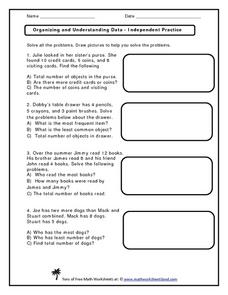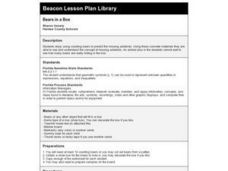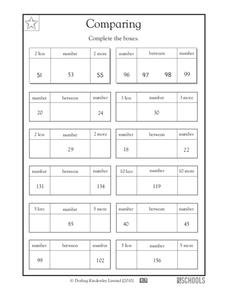Curated OER
Math – Comparing Numbers Up to 2-Digits
In this comparing numbers up to 2-digits learning exercise, students respond to 10 comparing numbers and 5 comparing sets questions.
Curated OER
Writing a Letter to the Editor
Students examine the structure and elements of a letter to the editor. They identify letter elements, read and discuss newspaper letters, and write and submit a letter to a local newspaper.
Curated OER
Identifying Patterns
Investigators examine the clues to complete 17 sequences by skip counting backwards. There are two examples to get them started, and all of these patterns include the first three numbers but are missing the last five. If you want...
Curated OER
Early Mental Math: Practice
Pupils start from a given number and count forward by 1s, 2s, and 10s. They "make ten" in 4 addition problems, and add or subtract 2 in the rest. Finally, they circle the odd numbers in a list from 1-14.
Curated OER
Organizing and Understanding Data - Independent Practice
Provide your first graders with an opportunity for independent practice organizing and understanding data. The ten story prompts on this three-page worksheet asks learners to solve problems involving concepts of the total number of...
Curated OER
Equal or Not Equal
Tiny mathematicians count the number of shapes (up to 8) in pairs of object groups and identify the sets as equal or not equal. Five practice problems. They also draw 2 groups of shapes that are not equal. A focused tool that...
Curated OER
Bears in a Box
First graders count bears to predict missing addends. They analyze the missing addend sentence: 7 + ? = 10 and count up from 7 to 10 and check to see if there are 3 bears in the box.
NWT Literacy Council
Readers Theatre Scripts
Engage and entertain young learners with this collection of readers theatre activities. With over 25 different scripts, a wide range of topics are covered from simple counting and rhyming exercises to adaptions of popular children's...
Curated OER
Polygons
Young scholars investigate the concepts related to the study of polygons. They specifically look at how angles is related. The lesson includes specific examples and dialogue to be used by the teacher during direct instruction and...
Curated OER
Guided Lesson Explanation for More, less, or Equal
How do you teach kindergartners to count? Use this scripted explanation to show pupils how to solve problems that ask them to determine whether the number of objects in one group is greater than, less than, or equal to the number of...
Curated OER
Naming the Pattern
In this pattern activity, 2nd graders complete fifteen number patterns and explain the counting pattern for each group. Students also complete five picture patterns and label each of the patterns.
Curated OER
Add Tens
Learners solve six story problems about adding 10s. Provide 10-rods or objects they can group into 10s to visualize what is being asked. Two of the problems provide irrelevant information; with discussion and guidance, this is also a...
Curated OER
Base Ten Blocks Rods and Flats (A)
Using visual cues and hands on manipulatives are great for conveying concepts in a concrete way. Learners are given a set of rods, they break the set up into flats, then count the rods left over to determine an answer. There are 5...
Curated OER
Representing Objects with Numbers
Because this step-by-step counting worksheet includes the answers, it may be best used as an all-class warm up. Learners focus on relating objects and numbers as they count five circles and choose which numeral represents the amount. The...
Curated OER
Make Ten Guided Lesson
Use these missing-addend problems to help your beginning mathematicians practice addition facts. They read sentences and solve, making 10 from different single-digit numbers. Each of these four problems is formatted differently, so the...
Curated OER
Investigation-How Many Toothpicks?
Seventh graders use toothpicks to investigate a series of designs and identify patterns. Data is organized and analyzed using tables and graphs, and students make generalizations using algebraic expressions.
Curated OER
Trick-or-Treat
Who has the most candy? Kids often have candy on the brain, so get them to learn in the process! Here is a great counting worksheet for Halloween week. Learners compare candy stashes between four pairs of kids. They count each stash,...
DK Publishing
Stars and Planets Connect the Dots
Reach for the stars with this cute connect-the-dots activity! Kindergartners practice their counting and number sequencing by connecting the numbers 1 through 6 or 10 in four different shapes. A rocketship is completed for them as an...
Curated OER
Number Match Worksheet
How many of each? There are eight sets of familiar objects here, and learners match them to the numeral on the right. Numbers range from three to twelve. Although the graphics aren't fantastic, the objective is clear and your budding...
Curated OER
Comparing
Examine short number sequences to help scholars explore value comparisons. They look at various given numbers (both two-digit and three-digit) and write in values that are less or more by specific one-digit numbers (i.e. three less, two...
Curated OER
Investigation - The Bakery Shop
Pupils use manipulatives to establish quantity. By singing a song titled "Five Little Cookies," students determine which strategy to use to find out how many cookies are left in the bakery shop.
Curated OER
Understand Categories of Shapes
This colorful set of shapes and figures is the data set learners need to fill out an extensive table. For each of 11 types of shapes or figures they record the quantity and how many corners and sides each has. This becomes more difficult...
Curated OER
Animal Syllables
Animal names are a great way to practice syllables with words your young scholars will be familiar with! Using images, students examine 7 animals and color in the number of paws that correspond with the number of syllables in that animal...
Curated OER
Matching Even and Odd Numbers
Although learners don't need to identify numbers as even or odd here, they do match each to a set of shapes. There are six numbers written numerically along with either odd or even. Scholars match each to a set of shapes with...























